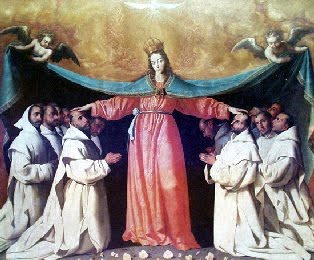 Today on the Carthusian calendar is the feast of Blessed Guglielmo da Fenoglio. His name in English most often appears as William of Fenoli or William of Fenol. An English-language publication on Carthusian saints written by a Carthusian monk shares the following about Blessed William:
Today on the Carthusian calendar is the feast of Blessed Guglielmo da Fenoglio. His name in English most often appears as William of Fenoli or William of Fenol. An English-language publication on Carthusian saints written by a Carthusian monk shares the following about Blessed William:William was born in the early twelfth century, in the township of Monferrato, in the diocese of Alba, in Northern Italy. His family was no doubt an ordinary, but very devout family. He was drawn to solitude and did in fact become a hermit. We may think that his life of prayer as a hermit deeply united him to God. However, a woman of ill repute came to disturb him in his hermitage. He was able to resist her temptations, but afterwards he realized that he needed the protection of a cloister.
So he took the road to the nearby Charterhouse of our Lady of Cazotto, Asti, and asked to be admitted as a brother. As Brother William, he became an outstanding member of the community. He faithfully followed the observance of the Rule. He looked upon his superiors only with the eyes of faith and was always disposed to obey them immediately. The virtue by which he shone the most was that of simplicity. “If the eminent practice of virtue is admirable when joined to the splendor of doctrine, better still is its charm when it has for its company the ingenuity, the candor, the simplicity of soul. This simplicity must serve as the supreme wisdom especially for those called to live in the obscurity of the cloister” (Statement of the Postulator). How well Saint Bruno’s words to the lay brothers of the Grande Chartreuse apply to William:
“As regards you lay monks, brothers so close to my heart, I have only this to say: My soul glorifies the Lord, since I can perceive the glories of His mercy toward you from the account of your beloved Father and Prior, who boasts a great deal about you and rejoices over you. I share in this joy, since God in His power never ceases to inscribe on your hearts, however little education you may have, not only love, but understanding, of His holy law. For you show by your lives what it is you really love, and what you know. That is to say, when you are careful and zealous to observe a genuine obedience, conceived not only as the carrying out of God’s commands, but as the original key to the spiritual life and its final stamp of authenticity, demanding as it does deep humility and outstanding patience, as well as sincere love for the Lord and our brothers, then it is clear that you are gathering with relish no less than the most delectable and life-giving fruits of Holy Scripture.”
His simplicity of heart was a great preparation for contemplation. His piety focused on Christ crucified and he could not think of the Passion of our Lord without becoming deeply afflicted. And so, freed from all fear and earthly plans, his only desire was for Eternity, preparing himself for it with constancy until his death, which occurred around the year 1200.
He was buried in the cloister cemetery of the Charterhouse, but God let it emphatically be known that He wanted him to be buried at the gatehouse, outside the enclosure, so that the faithful could come to pilgrimage to his tomb. It is this popular veneration century after century, with accompanying miracles, which are the proof of the sanctity of this humble brother of whom we know so little. Pope Saint Pius V authorized the transfer of his relics in 1568, and Pope Blessed Pius IX authorized in 1862 the veneration of Brother William, whose body was still incorrupt.











